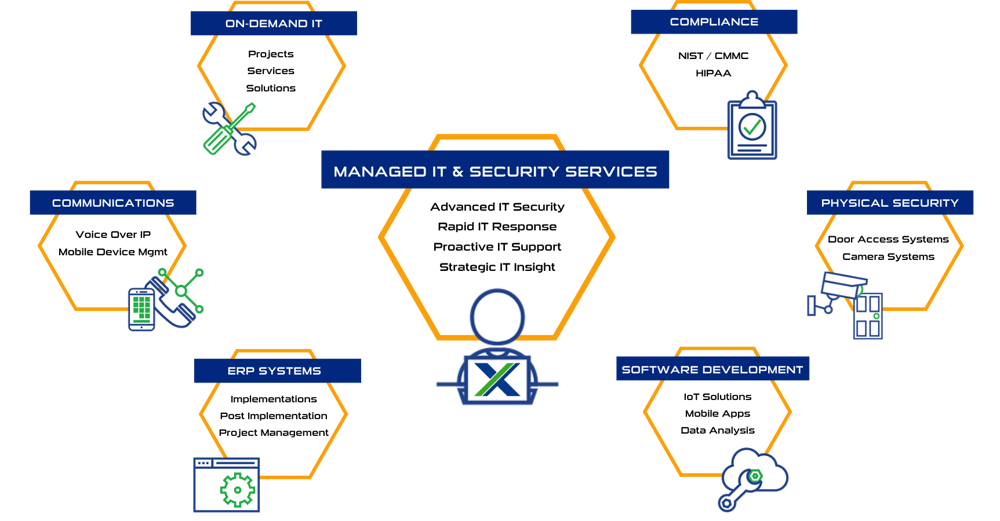On the Battle Front:
Protect Your Business from these cyber security threats in 2024
Have you ever lived in a small community where crime rates are so low that people genuinely feel comfortable leaving their front doors unlocked?

In a way, thats how business computing was 25 or so years ago...
You had locks on the doors of your digital network, but it didn’t really matter if you didn’t always use them. The worst that could happen was someone getting in and creating a little mischief, rather than doing real damage.
Now as we sit on the verge of 2024, things are completely different in our digital world. Today you don’t just want a lock on your door, you want 3 heavy duty locks that are bolted shut all the time. And an alarm. And cameras. And a huge security guy standing guard, complete with a very big scary looking dog on a chain.
These days, cyber criminals relentlessly target businesses of all sizes, all the time. And the attacks take many different forms, all with increasing sophistication.
Have you heard of ransomware attacks that have totally shut down businesses, making them virtual hostages with no access to their own data?
Or the horror of businesses having their data stolen and then sold on the dark web?
The consequences of a successful cyber attack can be utterly catastrophic, both in terms of financial losses and damage to your business’s reputation.
And cyber threats are not just becoming more common, they’re evolving fast. Keeping on top of your business’s cyber security has never been more crucial.
So, as we hurtle towards another new year, you’re probably left wondering what 2024 may have in store for us on the cyber front.

(By the way, we’ve written this guide not to scare you, but to educate you. Only when you understand how the burglars can get in, can you make sure all the windows and doors are firmly shut and locked.)
These are some of the specific cyber threats that will put your business at risk in 2024.
The Ransomware Renaissance
According to the Future of Cyber 2023 report by Deloitte, a staggering 95% of cyber security events are caused by human error. That’s right, in most cases, we are our own worst enemy.
Imagine the potential pitfalls when your workforce is scattered across multiple locations, each with their unique security challenges. Have you got that sick feeling in the pit of your stomach yet? Working from home presents a playground for cyber criminals. Why?
When you’re in an office environment, you’re protected by layers of protection, including corporate-grade firewalls and security protocols. But at home? You’re often reliant on the family Wi-Fi network that’s shared with lots of other people, some of whom have really bad security practices (do your teenagers use a different randomly generated password for every app they sign up to???)
The result? An open invitation to cyber criminals far and wide. And it’s not just about your network security. Your teams could be using their personal devices for work, devices that might not have the same level of protection as company-issued hardware.
Add to that the fact that important business data is now being accessed, stored, and transferred outside of your secure office environment… and you’ve got yourself a ticking time bomb.
The Internet of Targets
Ransomware is everywhere, and it’s about to get a makeover.
It’s a very specific kind of attack where criminals get into your network, lock you out to prevent you from accessing your own data, and then charge a huge fee to let you back in. There’s no guarantee they will, of course. And a full ransomware attack implemented well can be very, very hard to undo.
Cyber criminals are gearing up to unleash more sophisticated attacks, armed with the dark arts of machine learning and artificial intelligence. Expect them to fine-tune their extortion game, making it more efficient and more destructive.
They’re also setting their sights on bigger prizes. Brace yourselves for potential disruptions and big financial losses as they ransack their way through the digital realm.
Invisible Attacks that Never End
Advanced Persistent Threats (APTs) are the sneakiest of attacks, where criminals aim for long-term unauthorized access to your systems. They do it to monitor what you’re doing, and see what opportunities arise.
In 2024, they’re not just going to be lurking in the shadows; they’ll practically be invisible. APTs will use advanced evasion techniques, such as Living off the Land (LotL) attacks. That means they’ll use your own legitimate software and tools to waltz past your security controls.
Mobile Menace
Your mobile devices – those loyal sidekicks you take everywhere – are no longer safe either. In 2024, cyber criminals will take the battle to your phones and tablets. Expect to see a rise in phone-specific threats like malware, banking trojans that try to get your login details, and phishing attacks where they get you to use your real login data on a fake site.
Why? Because your mobile gadgets are treasure troves of personal and financial information. A breach could lead to identity theft, financial fraud, and unauthorized access to your most sensitive data.
Covert Attacks Through the Tools You Rely On

Supply chain attacks are expected to increase too. This is where criminals compromise trusted vendors or third-party service providers. They insert malicious code into legitimate software updates or gain privileged access to multiple organizations through these trusted entities.
Successful supply chain attacks can lead to unauthorized access, data theft, and long-term security risks.
AI: The Game Changer
Artificial Intelligence (AI) is the ace up the sleeves of both attackers and defenders. Cyber criminals are using AI to automate attacks, improve evasion techniques, and craft clever social engineering tactics (where they gain access to systems by influencing people to take certain actions).
On the flip side, businesses are adopting AI-powered security solutions to spot threats in real-time.
AI is the new sheriff in town, playing a key role in threat intelligence, anomaly detection, and incident response. It’s the future of cyber security operations, and it’s here to stay.
What About the Cloud?
When it comes to cloud computing, the sky’s not the limit; it’s the gateway to innovation. But as we become increasingly reliant on the cloud and data that we can access on any device, anywhere at any time, we need to be mindful of the unique security challenges it presents.
That's why it deserves its own section in this guide.


Data Breaches
Data breaches can occur due to misconfigurations, weak access controls, or insider threats. Robust security measures are paramount.
Insider Threats
Trust in cloud service providers is high, but businesses still face risks from their own employees or insiders. Insider threats can involve intentional data theft, unauthorized access, or accidental data exposure.
Shared Infrastructure
Cloud services operate on shared infrastructure, introducing the risk of vulnerabilities that could lead to unauthorized access to other tenants’ resources.
Lack of Control & Visibility
Relinquishing some control to cloud providers is part of the deal, but it can make it challenging to detect and respond to security incidents.
Compliance & Regulatory Requirements
Regulated industries need to make sure their cloud deployments comply with industry-specific regulations and standards. This includes addressing data residency, privacy, and data protection obligations. Careful evaluation of provider compliance capabilities is essential.
Data Loss & Recovery
Cloud outages or disruptions can lead to data loss or unavailability. Robust data backup and recovery strategies, including regular backups, redundant systems, and disaster recovery plans, are vital. Understanding provider backup and recovery mechanisms and aligning SLAs with business needs is key.
10 Steps to Strengthen Your Defenses
One thing it’s important to realize is that the world of cyber security is in a constant state of flux. To stay ahead of the game and safeguard your remote workers and business data, you must embrace the principles of continuous monitoring and adaptation.
1. Audit
Before you make any changes, take stock of how well protected your business already is. Carry out a thorough audit to identify your areas of strength and weakness. Understand your assets, from critical data to vulnerable entry points. This will act as a navigational chart, helping you make informed decisions about where to allocate resources.
2. Prevention
Strengthen your defenses with robust security controls. Implement firewalls, intrusion detection and prevention systems, secure network architecture, and enforce strong access controls. By layering your defenses, you create multiple barriers for would-be attackers, significantly reducing the risk of successful cyber assaults.
3. Detection
Despite your best efforts, some threats may still sneak past your defenses. That’s where detection mechanisms come into play. Invest in security monitoring tools, log analysis, and threat intelligence to identify and alert you to potential security incidents. Swift detection enables rapid response, mitigating the impact of cyber attacks.
4. Incident Response
Breaches will happen. Having well-defined incident response procedures in place is crucial. These procedures should outline the steps to take when a security incident occurs, from containment and investigation to mitigation and recovery. Your incident response team should work together to minimize the damage and restore normal operations.
5. Vulnerability Management
Regularly assess and test for vulnerabilities in your systems, applications, and network infrastructure. Vulnerability assessments and penetration testing are your allies in this battle (penetration testing is where good guys try to break into your network to see where there are opportunities). Identify and patch weaknesses quickly.
6. Awareness & Training
Your people are both your greatest asset and biggest potential vulnerability. Invest in regular cyber security awareness training. Educate your employees about best practices, social engineering threats, phishing attacks, and the importance of strong passwords. If they feel they can recognize and respond effectively to potential threats, that will be a massive boost to your business’s overall security posture.
7. Data Protection & Encryption
Protect your data with encryption. Even if an attacker gains unauthorized access, encrypted data remains unreadable without decryption keys. You should also establish data backup strategies and disaster recovery plans to protect against data loss.
8. Compliance & Regulations
Make sure your business meets legal and regulatory requirements related to privacy, data handling, and security. This might involve implementing specific controls, conducting audits, and maintaining documentation to demonstrate your compliance.
9. Continuous Monitoring & Improvement
Remember, great cyber security is not a one-time event. Continuously monitor your systems, networks, and what people are doing to detect anomalies and potential breaches. Regularly assess and update your security measures based on emerging threats and changing best practices. By staying agile and adaptable, you’ll ensure that your cyber security measures remain effective and up to date.
10. Choose The Right IT Partner
Get this one right and everything else immediately gets easier and faster with less hassle for you. Find a partner who really understands cyber security and can design the most appropriate way to protect your specific business. For example, locking everything down is rarely the right approach for any business, as it can encourage staff to cut corners. Imagine a physical security door that staff use several times a day but takes 2-3 minutes to unlock each time. At some point, someone’s going to prop it open for a few minutes to make their life easier. It’s no different with cyber security.

With every year that passes, cyber security becomes increasingly more complex.
But when you stay educated about evolving threats, what the dangers are, and stay on top of your security measures with a multi-layered approach, you keep your data and staff better protected.
Have Questions? Let's Chat!
Some of Our Capabilities

Systems X provides IT solutions and strategic IT guidance with a human touch. Our purpose is to empower you to make better decisions with high-quality data and world-class service. Our creative thinking and purpose-driven solutions are the fundamental gears to guide the strategy that will connect your business with what’s next!!
Sales: (586) 884-7835
Service Desk: (586) 991-1050
Managed Services in Chesterfield, MI
50801 E. Russell Schmidt Blvd, Chesterfield, MI 48051
Managed IT Services in Detroit
400 Renaissance Center Suite 2600 - #2073, Detroit, MI 48243
Managed IT Services in Ann Arbor
2723 S State St Suite 150 - #1690, Ann Arbor, MI 48104
Managed IT Services in Cleveland
1300 Superior Ave #3413, Cleveland, OH 44114
DUNS No.: 79-009-7088
CAGE Code: 8YVR5
NAICS Codes: 541511, 541512, 541513, 541519, 517911, 611420
© 2025 Systems X Corporation